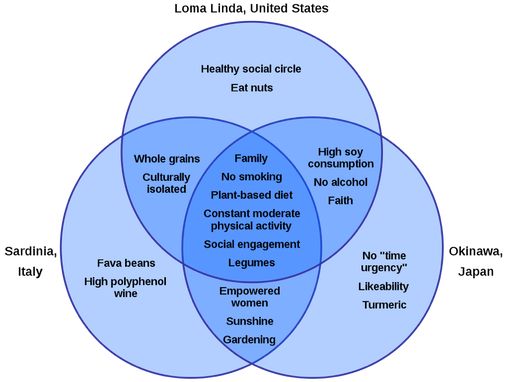 We’re not talking about politics here, we’re talking about Dan Buettner’s National Geographic cover story a while back entitled, “The Secrets of a Long Life.” Buettner identified five regions in the world as evidence for his argument that certain common factors contribute to some populations living healthier and longer lives than others. The places he identified as Blue Zones (versus Red Zones that are less healthy) span from Okinawa, Japan to the Seventh-day Adventists in Loma Linda, California. If he were to do smaller scale studies, he would surely find cohousing communities to be blazing blue spots on the global map. Why? Here is the list of the nine lifestyle commonalities in these zones:
A cohousing community is designed for many of these lifestyle factors, and it wouldn’t take much effort to hit all nine aspects of Blue Zones easily. The most obvious Blue lifestyle feature associated with cohousing is social engagement—the common house hub where dinners are served, celebrations and performances happen, young and old pool sharks compete, laundry is folded over chit-chat, nightly gatherings around the fireplace in winter, and porch eating in summer. Don’t discount the socializing that happens outside of the Common House—these too are designed into our cohousing site plan—nodes for hanging out throughout the commons with benches, hot tubbing, gardening, shop work, music jams, impromptu outings and team gatherings. Family engagement: not only do many cohousers move in with their family but also living in community can form a sort of secondary family over time. Young parents will have a bonus tier of eager “grandparents” to watch over their children; someone returning from a hospital procedure will have folks tending to their post-op welfare. Constant and moderate physical activity are also intentionally achieved by design. Unlike most American homes, you won’t be able to drive a car into your garage and simply vanish through a garage door because all the parking is on the perimeter. Cohousing anti-isolation design has your neighbors smiling at you whether you’re walking, dancing, riding a wheelchair or scooter as you pass by their porches to get to your condo. The garden, shop and meditation huts are at a bit of elevation from the main commons and Common House, so some trips up there are built-in potentials for increased heart rate (and rewarding views of Mt. Spokane and the city). Stress reduction? Dinner creation and cleanup are taken care of most nights by someone else. If your child is sick and you can’t miss work, there’s a kids’ room in the Common House and retirees that have time to help. We will be sharing items from trucks to ginger powder—there will be someone right around the corner that has what you need to finish your project. More legumes and vegetables? We’ve got omnivores among us as well as vegetarians, and we’ll be cooking for both. You’ll always have the opportunity to increase your vegetable intake. Purpose and spirituality? All the way back at the original planning session, we slated a spot above the garden for a sanctuary, otherwise known as the meditation hut. With a quiet place to reflect, purpose can be more easily fathomed, yes? Additionally, living harmoniously in community is its own built-in purpose. A Venn diagram of longevity clues from Okinawa, Sardinia, and Loma Linda. This Venn diagram of longevity has a few other aspects that should make you smile like “empowered women”—we have plenty of em (see this month’s other article on three women from our cohousing group nominated for Spokane Women of the Year). Sunshine? We’ll have lovely places all around to spend more time outdoors. So, step into a micro Blue Zone with us at Haystack Heights and you’ll be giving your mind/body and fellow cohousers some big doses of wholesome lifestyle goodness.
3 Comments
Nicole Morris
6/22/2022 12:06:40 pm
I ordered a job spell on a Friday night and on Monday the place I applied for a job called for me to come by their office. They gave me the job I applied for and made me an offer of more per hour than I have ever made in my life! I am so happy! Government jobs sometimes are a slow process. You somehow managed to speed up that process, and I start in just a few days! DR EMU I will be forever grateful thanks once again. You can call on him for help on his email address [email protected] or add him up on his WhatsApp +2347012841542. DR EMU also lent a helping hand to the following } 1. GETTING YOUR EX LOVER BACK. 2. WINNING LOTTERIES. 3. CHILD BEARING. 4. BREAKING OF GENERATION COURSE. 5. GETTING OF JOB. 6. JOB PROMOTION. 7. HERBAL CARE. 8. SPIRITUAL PROTECTION. 9. HERBAL CARE. 10. SPIRITUAL PRAYER. E.T.C. Facebook page https://web.facebook.com/Emu-Temple- 104891335203341
Reply
Manuel Franco
3/27/2023 09:22:48 am
Reply
Leave a Reply. |
 RSS Feed
RSS Feed